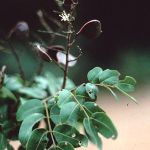| Common Name: |
Copaiva |
| Other Names: |
Copaiba |
| Botanical Name: |
Copaifera lansdorffii |
| Genus: |
Copaifera |
| Family: |
Leguminosae |
| Native Location: |
Brazilian rainforests |
| Cultivation: |
Well-drained, sandy soil in shade and high humidity. |
| Propagation: |
By softwood cutting in spring. |
| Harvest: |
Resin is tapped from trees at intervals (the hole is sealed afterward) and used in infusions or distilled for oil. |
| Height: |
18-20m (60-70ft) |
| Width: |
10-15m (30-50ft) |
| Hardiness: |
Min. 13-15°C (55-59°F) |
| Parts Used: |
Oleo-resin |
| Properties: |
An aromatic, antiseptic, stimulant herb with a bitter, burning taste. It improves digestion, has diuretic and expectorant effects, and controls bacterial infection. |
| Medicinal Uses: |
Internally for cystitis, bronchitis, vaginal discharge, hemorrhoids, and diarrhea. Externally for chilblains, sores, eczema, and psoriasis. Often combined with Agathosma spp. (See. Oval-leaf buchu), Piper cubeba (See, cubeb), and Santalum album (See, Indian Sandalwood). Excess is purgative and may cause skin rashes and kidney damage. |
| Economic Uses: |
An important fixative in perfumes (especially those with violet, woody, and spicy notes) and a main source of copal, a resin used in varnishes and lacquers. Usable direct from the tree as a substitute for diesel oil. |
| Bibliography: |
Encyclopedia of herbs by Deni Brown Copyright © 1995, 2001 Dorling Kindersley Limited. pg 179 |

